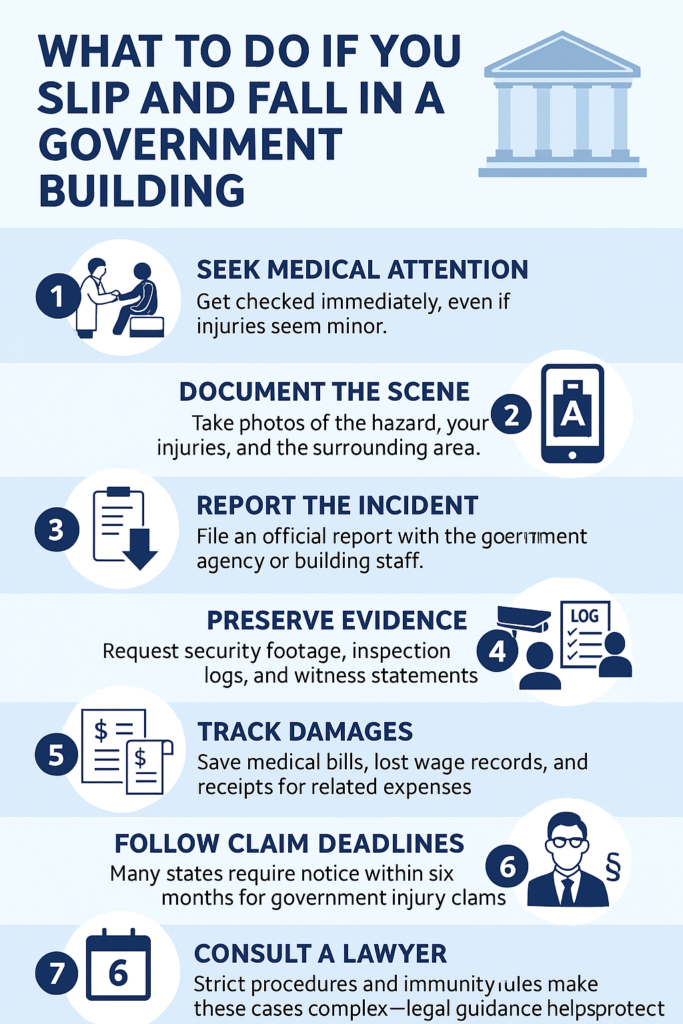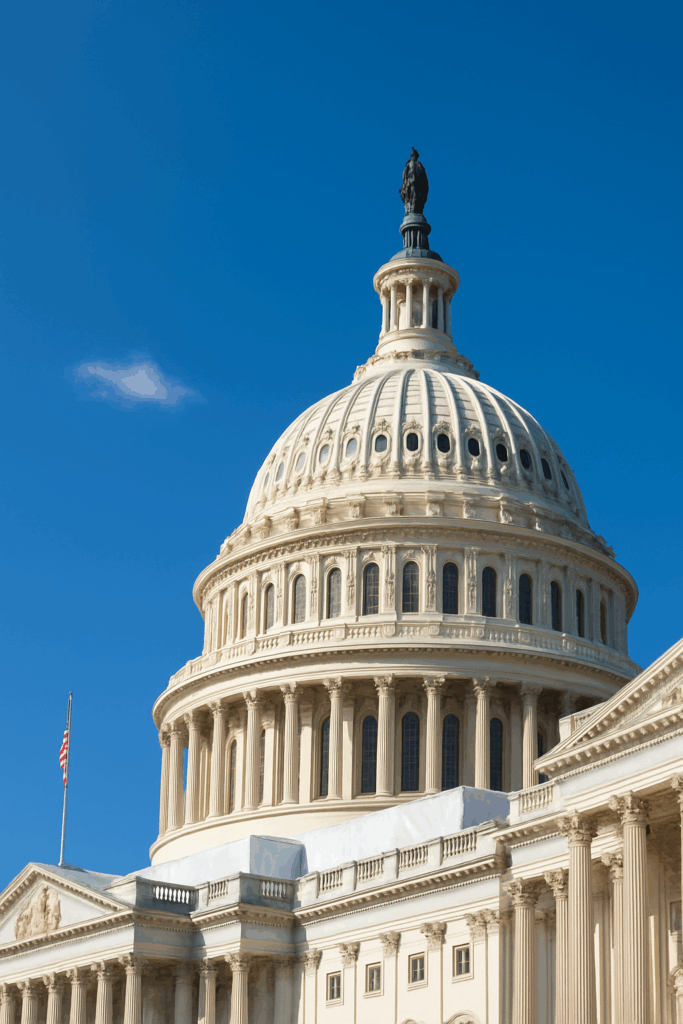
Wondering, “what to do if you slip and fall in a government building”? Here are the most important steps to protect your health and legal rights:

Taking these steps after a slip and fall in a government building increases your chances of recovering compensation for medical costs, lost wages, and other damages.
A slip and fall in a government building can be devastating—physical pain, medical bills, and complicated legal hurdles. When it happens at a courthouse, DMV, or city hall, you’re not just dealing with injuries—you’re dealing with government immunity, notice rules, and tight deadlines.
Take, for example, a recent case in Arizona where a visitor slipped on a wet floor inside a public building and pursued a claim under Arizona’s strict notice-of-claim laws. In California, similar accidents in city or state buildings must often be reported within six months under the California Government Claims Act. In Texas, falls in courthouses or city offices trigger their own procedural hurdles, while Georgia requires compliance with unique notice and timing rules. These differences highlight why location matters when a slip and fall occurs in a government building.
Real-world incidents illustrate how severe these accidents can be. In Sacramento, a man who broke into an office complex slipped from a sixth-floor balcony and later died. In Dallas, police reported the death of a person who fell from a building near Victory Park in the early morning hours.
In this guide, we’ll walk through who’s responsible for government building maintenance, when you can sue, what to do immediately after a fall, and how strict deadlines apply in each of your states (Arizona, California, Texas, Georgia). Let’s start.
Responsibility for a government building depends on the level of government that owns or operates it.
A city may be in charge of maintaining a local library or DMV office, while a county could oversee a courthouse or administrative center. State agencies often control capitol buildings, universities, and state offices, while federal facilities include post offices, Social Security buildings, and courthouses.
In many cases, liability doesn’t stop with the government agency itself. Maintenance duties are often contracted out to private companies, such as janitorial services or repair crews. If a fall is tied to negligence (say, a contractor failed to clean up a spill or repair a broken step), both the government entity and the contractor could share responsibility.
Determining who is legally accountable requires knowing exactly which agency owns the property and who was tasked with day-to-day upkeep.
Suing the government is more complicated than suing a private property owner because of a legal concept known as sovereign immunity. This principle protects government agencies from many lawsuits, but it has been partially waived by laws like the Government Claims Act at the state level or the Federal Tort Claims Act (FTCA) for federal property.
To succeed in a fall case, you must prove that a dangerous condition existed, such as a wet floor or broken handrail, and that the agency had notice of it. Notice may be actual (meaning staff knew about the hazard) or constructive, which means the condition existed long enough that it should have been discovered during reasonable inspections.
Liability only applies when officials failed to fix the hazard or warn the public in a timely way.

After a fall in a public building, the shock may fade but the questions about what comes next often feel overwhelming. Knowing what steps to take can help protect your health, preserve your rights, and prepare you for the claims process.
Take photographs of the exact area where you fell, capturing both close-ups and wide views that show the location in context. Note any details such as lighting, spills, loose flooring, or broken railings. If possible, save the clothing and shoes you were wearing, as these can later help show the circumstances of your fall.
Request an incident or occurrence report from staff or security. This creates a record that the fall took place on government property. Keep your description clear and factual, focusing on time, place, and what you observed, without speculating about blame.
Video footage and maintenance logs are often erased or replaced quickly. To avoid losing important evidence, send a written request to the agency or facility asking them to preserve security footage, inspection records, and any maintenance notes from the day of your fall. Sending this by certified mail or through an official portal ensures you have proof of the request.
If others saw the fall or knew about the hazard beforehand, ask for their names and contact details. A brief statement from a witness can strengthen your case, especially if they can confirm that the dangerous condition had been present for some time.
Government buildings are subject to public record laws. Submitting a records request can help you uncover prior complaints, inspection schedules, or maintenance reports for the same location. These documents may establish that officials knew, or should have known, about the hazard.
From the beginning, save all medical bills, receipts, and documentation related to your injury. This includes costs for treatment, prescriptions, medical devices, transportation, and lost wages. Keep everything organized in one place, as you will need these details to support your claim.
If you are contacted by insurance representatives or government claims staff, stick to factual details about the incident. Avoid making broad statements or signing documents without reviewing them carefully. Broad medical releases, for example, can give agencies access to unrelated health information.
Notify the agency responsible for the building so they are aware of the hazard. This step not only helps protect others but also establishes a record that the issue was reported. Ask for the name of the claims officer or department handling injury reports.
Avoid posting about your fall or recovery on social media. Even casual updates or photos can be taken out of context and used to question the seriousness of your injuries.
Government claims involve short deadlines and strict procedures. Speaking with an attorney early can help ensure that evidence is preserved and that your notice of claim is filed correctly and on time. Even if you do not pursue a lawsuit immediately, professional guidance can prevent costly mistakes.
Strict deadlines make government slip and fall cases especially challenging.
In most states, you must file a notice of claim within six months of the incident. This is much shorter than the typical statute of limitations in personal injury cases. The notice must include details like the date, time, location, and circumstances of the slip and fall, along with the damages you are claiming. Filing with the wrong agency or missing the deadline almost always results in dismissal.
If your fall happened on federal property, the rules are different. Under the FTCA, you must submit an administrative claim to the appropriate federal agency within two years of the accident, usually using Standard Form 95. The agency then has six months to accept, deny, or ignore the claim.
Only after this step can you take the case to federal court.
A slip and fall in a government building can leave you facing more than physical pain. The legal process that follows is often complex and filled with strict deadlines.
Thompson Law understands the unique challenges of these cases and has the experience to guide you through each step, from preserving evidence to filing the required notices on time.
Contact Thompson Law today for a FREE CONSULTATION. Our team will review your situation, explain your legal options, and help you pursue the compensation you deserve with confidence.

Serving clients in:
Yes, but suing a government agency is different from suing a private property owner. Claims are governed by the Government Claims Act or the Federal Tort Claims Act (FTCA), depending on where the fall occurred. You must follow strict notice deadlines and prove that the agency knew about the hazard and failed to address it.
Most states require a notice of claim within six months of the slip and fall in a government building. For federal property, you generally have two years to submit an administrative claim using Standard Form 95 under the FTCA. Missing these deadlines usually means losing your right to compensation.
Strong evidence includes photographs of the hazard, incident reports, preserved video footage, witness statements, and maintenance records. Keeping medical bills, lost wage documentation, and other proof of damages is also essential to support your claim.
No. Liability only applies if a dangerous condition existed, the agency had notice of it, and officials failed to fix it or warn the public in a reasonable timeframe. Agencies often raise defenses like sovereign immunity, discretionary function immunity, or arguing that the hazard was “open and obvious.”
If your slip and fall in a government building claim succeeds, you may recover medical expenses, lost wages, rehabilitation costs, and related out-of-pocket expenses. Punitive damages are not available against government entities, but an attorney can help maximize your recovery through proper documentation.
Yes. Government claims involve short deadlines and strict rules. An experienced attorney can preserve evidence, file the notice of claim correctly, and fight back against common government defenses, giving you the best chance of success.
Sí. Hablamos español. We provide bilingual support so Spanish-speaking clients have full access to our attorneys.
Contact Thompson Law today for a FREE CONSULTATION.






Thompson Law charges NO FEE unless we obtain a settlement for your case. We’ve put over $1.9 billion in cash settlements in our clients’ pockets. Contact us today for a free, no-obligation consultation to discuss your accident, get your questions answered, and understand your legal options.
State law limits the time you have to file a claim after an injury accident, so call today.